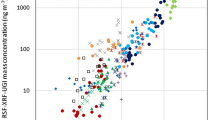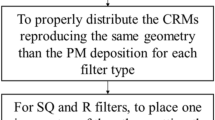Abstract
The portability, ease of use, relative lower cost of procurement and simple maintenance of a handheld X-ray fluorescence analyzer makes it a potential alternative for air particulate analysis especially in highly polluted and economically disadvantaged regions of the world. Thus, this study assessed the performance of such analyzer in characterizing aerosol laden filters. Spectra of Certified Reference Materials (NIST 2783 CRM for aerosol filters) measured with a handheld X-ray fluorescence analyzer were calibrated and fitted using iterative nonlinear least-square fitting procedure provided by the International Atomic Energy Agency-Quantitative X-ray Analysis System. Elemental sensitivity calibration curves, method detection limits, uncertainty estimates of K- and L- X-ray lines in the elemental range 18 < Z < 39 and 47 < Z < 83 respectively were determined for four excitation conditions [High (Hi), Main (Ma), Light (Li) and Low (Lo)]. Signal counts for \(K_{\alpha {\text{and}} \beta }\) (Ni, Zn, Se) and \(L_{\alpha {\text{and}} \beta }\) (Pt, Te, Au) lines of the CRM’s were used to validate the analytical method. Concentrations values were evaluated for trueness and precision. Hi excitation condition has the least sensitivity (5 times less than Ma, 30–40 times less than Lo and more than 100 times lower than Li) within varying range of atomic number. However, Hi (R2 = 0.99) and Ma (R2 = 0.96) condition had the best overall trueness and precision score within an acceptable relative standard deviation ≤ 6% for the six CRM’s evaluated.







Similar content being viewed by others
References
Aceto M, Agostino A, Fenoglio G, Capra V, Demariaf E, Canciang P (2017) Characterization of the different hands in the composition of a 14th century breviary by means of portable XRF analysis and complementary techniques. X-Ray Spectrom. https://doi.org/10.1002/xrs.2768
Alvarez RP, Markowicz A, Wegrzynek D, Cano EC, Bamford SA, Torres DH (2007) Quality management and method validation in EDXRF analysis. X-Ray Spectrom 36:27–34
Bac VT, Kregsamer P, Marckowicz A (2003) Elemental sensitivity method in XRF analysis of PM10 aerosol filters. Nucl Sci Tech 2:18–28
Bernick MB, Campagn PR (1995) Application of field-portable X-ray fluorescence spectrometers for field-screening air monitoring filters for metals. J Hazard Mater 43:91–99
Birks LS, Gilfrich JV, Burkhalter PG (1972) Development of X-ray fluorescence spectroscopy for elemental analysis of particulate matter in the atmosphere and in source emissions. EPA-R2-72-063
Bull A, Brown MT, Turner A (2017) Novel use of field-portable-XRF for the direct analysis of trace elements in marine macroalgae. Environ Pollut 220(A):228–233
Cave MR, Butler O, Cook JM, Cresser MS, Gardend LM, Miles DL (2000) J Anal At Spectrom 15:181–235
Chen JJ, Shugar A, Jehle A (2018) X-radiography of cultural heritage materials using handheld XRF spectrometers. X-Ray Spectrom 2018:1–8
Crocombe RA (2018) Portable spectroscopy. Appl Spectrosc 72(12):1701–1751
Dao E, Zeller MP, Wainman BC, Farquharson MJ (2018) Feasibility of the use of a handheld XRF analyzer to measure skin iron to monitor iron levels in critical organs. J Trace Elem Med Biol 50:305–311
Fleming DEB, Bennett SR, Frederickson CJ (2018) Feasibility of measuring zinc in human nails using portable X-ray fluorescence. J Trace Elem Med Biol 50:609–614
Fleming DEB, Gherase MR, Anthonisen M (2013) Calibrations for measurement of manganese and zinc in nail clippings using portable XRF. X-Ray Spectrom 42(4):299–302
IAEA (2005) Quantitative X-ray Analysis System, QXAS. XRF Group, International Atomic Energy Agency’s Laboratories, Seibersdorfp 214
Jones MC, Williams-Thorpe O, Potts PJ, Webb PC (2007) Using field-portable XRF to assess geochemical variations within and between dolerite outcrops of Preseli, South Wales. Geostan Geoanal Res 29(3):251–269
Kainth HS, Singh T, Shahi JS, Mehta D, Kumar S (2018) Instrumental detection limit and sensitivity of K and L shell X-ray emission lines of 17Cl, 37Rb, and 38Sr elements using PC-WDXRF spectrometer. X-Ray Spectrom 2018:1–7
Karydas AG, Padilla-Alvarez R, Drozdenko M, Korn M, Guzman MO (2014) Handheld XRF analysis of old Mexican feather headdress in the Weltmuseum Vienna. X-Ray Spectrom. https://doi.org/10.1002/xrs.2529
Melquiades FL, Appoloni CR (2004) Application of XRF and field portable XRF for environmental analysis. J Radioanal Nucl Chem 262:533–541
Polkowska-Motrenko H, Fuks L (2010) Proficiency testing schemes on determination of radioactivity in food and environmental samples organized by the NAEA. Poland Nukleonika 55(2):149–154
Sa’adeh H, Chiari M (2019) Atmospheric aerosol analysis at the PIXE–RBS beamline in the University of Jordan Van de Graaff accelerator (JUVAC). X-Ray Spectrom. https://doi.org/10.1002/xrs.3014
Shakhashiro A, Fajgelj A, Sansone U (2007) Comparison of different approaches to evaluate proficiency test data. In: Fajgelj A, Belli M, Sansone U (eds) Combining and reporting analytical results. RSC Publishing, Cambridge, pp 220–228
Vanhoof C, Bacon JR, Ellis AT, Fittschen UEA, Vincz L (2019) 2019 atomic spectrometry update—a review of advances in X-ray fluorescence spectrometry and its special applications. J Anal At Spectrom. https://doi.org/10.1039/c9ja90042j
Acknowledgements
Authors are grateful for the Group Fellowship Training (FS-NIR7004-1802257), the use of the spectrometer and standards granted them by the International Atomic Energy Agency (IAEA) at the Agency’s Nuclear Science and Instrumentation Laboratory, Seibersdorf, Austria. We appreciate Prof. Piet Van Espen of Antwerp University Belgium, Drs Roman Padilla Alvarez and Allessandro Migrioli of IAEA in Seibersdorf for their mentorship, and Ms Gunchin Gerelma (Vienna University of Technology, Atominstitut, Austria) for her support.
Funding
This research did not receive any funding from public agencies, commercial, or not-for-profit sectors.
Author information
Authors and Affiliations
Corresponding author
Ethics declarations
Conflict of interest
The authors declare that no conflict of interest exists.
Rights and permissions
About this article
Cite this article
Abiye, O.E., Ugwumadu, C.E., Kamara, A.J. et al. Sensitivity Calibrations of K- and L-shell X-ray Lines for Elemental Analysis of Air Particulate Samples Using a Handheld XRF Spectrometer. Aerosol Sci Eng 5, 127–135 (2021). https://doi.org/10.1007/s41810-021-00089-3
Received:
Revised:
Accepted:
Published:
Issue Date:
DOI: https://doi.org/10.1007/s41810-021-00089-3




